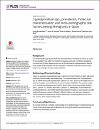Cryptosporidium spp., prevalence, molecular characterisation and socio-demographic risk factors among immigrants in Qatar.

عرض / فتح
التاريخ
2019-10-01المؤلف
Boughattas, SoniaBehnke, Jerzy M
Al-Sadeq, Duaa
Ismail, Ahmed
Abu-Madi, Marawan
BOUGHATTAS, SONIA
...show more authors ...show less authors
البيانات الوصفية
عرض كامل للتسجيلةالملخص
The World Health Organization WHO has estimated that in developed countries, up to 30% of the population may suffer from foodborne diseases each year, and that in developing countries up to 2 million deaths per annum can be attributed to cryptosporidiosis. Reports have already emphasized the role of immigrants in outbreaks of parasitic diseases especially those working in food processing industries. Herein we assessed Cryptosporidium spp. infections among immigrants in Qatar with a special focus on food handlers and housemaids. The overall prevalence of Cryptosporidium spp. by q-PCR among 839 asymptomatic subjects was 4.5%. Based on the Gp60 gene, the majority of isolates were identified as C. parvum subtype IIdA20G1b. The positive sample for C. hominis was subtyped as IeA12G3T3. Seven mixed infections were also identified (four C. parvum + C. hominis, and three C. parvum + C. meleagridis). The prevalence of Cryptosporidium spp. did not differ significantly between the sexes or age classes but varied significantly between subjects affiliated to different religions with the lowest prevalence among the Muslims. Multifactorial analysis retained also marked significance with education, income, and a house contents index. Our results contribute to a better understanding of the epidemiology of cryptosporidiosis and the risk factors associated with the likelihood of carrying this infection among immigrant workers from developing countries.
المجموعات
- أبحاث مركز البحوث الحيوية الطبية [840 items ]

